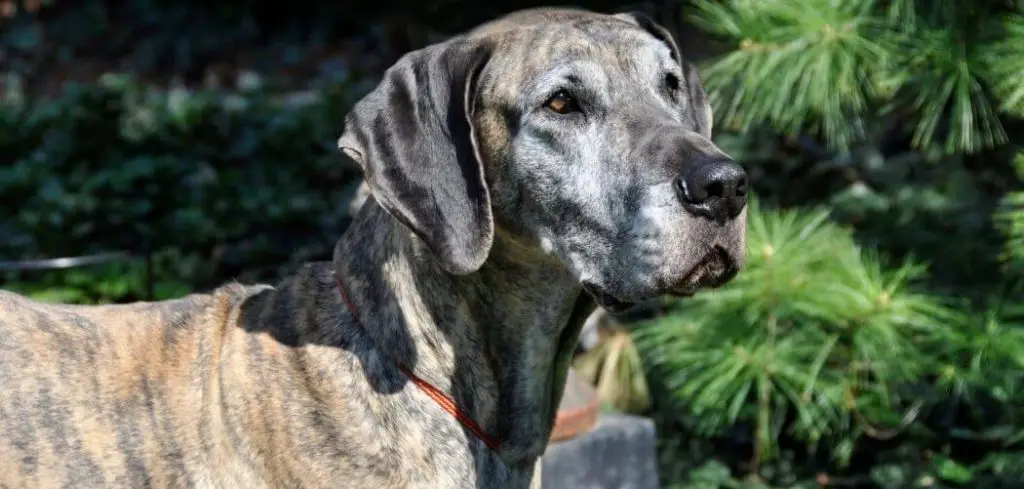When an older dog begins to just stand and stare for extended periods, it can be worrying for pet owners.
Recognizing the causes early and responding appropriately can help maintain your dog’s comfort and safety.
We outline the common reasons for an old dog just standing and staring, what you can do at home, and when to seek veterinary help.
Old Dog Just Standing and Staring — Why It Happens
An old dog just standing and staring can stem from a variety of physical, neurological, and cognitive issues. Age-related sensory decline, pain, or confusion may make your dog pause and focus on a single spot. Metabolic disorders, vision or hearing loss, and even neurological conditions can contribute.

Old Dog Just Standing and Staring: Common Causes
Cognitive Dysfunction
Canine cognitive dysfunction (similar to dementia in humans) can cause disorientation and repetitive behaviors such as standing and staring.
Dogs with cognitive decline may appear confused, forget routines, or get “stuck” in one position. You might notice increased sleep disturbances, anxiety, or changes in social behavior.
Early detection is important to slow progression and improve quality of life through environmental enrichment, medications, and supportive routines.
Read more: Old Dog Just Standing and Staring and Shaking (Here’s Why)
Vision Impairment
Age-related vision loss can make dogs hesitant to move or explore, leading to prolonged staring at objects or spaces they find unfamiliar.
A dog with impaired vision may freeze when navigating new areas or obstacles. Signs include bumping into furniture, reluctance to move, and staring at walls or corners.
Veterinary assessment and home modifications, such as increased lighting or tactile cues, can reduce anxiety and prevent injury.
Hearing Loss
Hearing impairment can cause an older dog to appear fixated on certain stimuli or stay motionless while trying to detect sounds.
Owners may notice reduced response to verbal cues, sudden startling, or attentive staring toward a direction without visible stimuli.
Addressing hearing loss with patience, hand signals, and environmental adjustments can help your dog feel more secure.
Pain or Discomfort
Chronic pain from arthritis, hip dysplasia, or spinal issues can make movement uncomfortable, causing dogs to stand still and stare.
Affected dogs may show stiffness, reluctance to lie down, or difficulty climbing stairs. Pain can lead to stress, further limiting mobility, so timely veterinary intervention, pain management, and supportive care are essential.
Seizures or Neurological Conditions
Partial or mild seizure activity can present as staring spells or motionless behavior in senior dogs.
Other signs may include twitching, drooling, or brief disorientation. Seizures can be subtle in older dogs, so noting patterns and frequency is important for veterinary diagnosis. Early treatment helps reduce complications and improves safety.
Anxiety or Stress
Environmental changes, loud noises, or separation anxiety can cause older dogs to become hyper-focused and stand still while staring.
Dogs may display panting, pacing, or sudden freezing in response to stressors. Behavioral modification, calming strategies, and safe spaces can help reduce anxiety-driven staring.
What to Do If Your Old Dog Is Just Standing and Staring
Monitor your dog’s behavior to identify patterns, triggers, and any accompanying symptoms like trembling, disorientation, or pain.
Maintain a safe environment by removing obstacles, securing stairs, and preventing access to potentially dangerous areas.
Provide mental and physical stimulation to keep your dog engaged, including gentle play, short walks, and puzzle toys suited for senior dogs.
Track your dog’s daily routines and behavior changes to provide accurate information to your veterinarian.
Work closely with your veterinarian to determine underlying causes and develop a tailored care plan, whether it involves pain management, cognitive support, or sensory assistance.
When to Call or Visit Your Vet
Seek immediate veterinary attention if staring is accompanied by sudden disorientation, seizures, loss of mobility, or other acute behavioral changes.
If your dog appears to be in pain, has difficulty standing, or shows reluctance to move, prompt assessment is important.
Persistent staring combined with confusion, incontinence, or aggression may indicate cognitive or neurological disorders requiring professional management.
Veterinary evaluation is also essential if you notice rapid decline in vision or hearing, as early intervention can improve your dog’s quality of life.
Read more: Old Dog Going in Circles (Here’s Why)
Key Takeaway
When an older dog just stands and stares, it may be related to cognitive decline, sensory impairments, chronic pain, neurological conditions, or stress.
Careful observation, environmental adjustments, and timely veterinary care are essential to ensure your senior dog’s safety and comfort.
With attentive home care and professional guidance, you can help your dog maintain confidence, engagement, and quality of life in their golden years.
